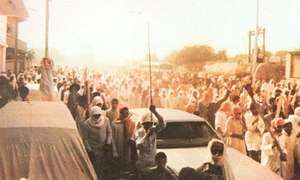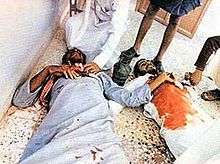1979 Qatif Uprising
The 1979 Qatif Uprising was a period of unprecedented civil unrest that occurred in Qatif and Al-Hasa, Saudi Arabia, in late November 1979. The unrest resulted in 20-24 people killed in what was described as a sectarian outburst of violence between the Shi'a minority and Sunni Majority in Saudi Arabia and the beginning of the modern phase of the Qatif conflict.
| 1979 Qatif Uprising | |||
|---|---|---|---|
| Part of the Qatif conflict | |||
 Demonstrators in Safwa City during November 1979 | |||
| Date | 26 November – 3 December 1979 | ||
| Location | |||
| Caused by |
| ||
| Methods |
| ||
| Resulted in |
| ||
| Parties to the civil conflict | |||
| |||
| Lead figures | |||
| |||
| Casualties | |||
| Death(s) | 20[1]–24[2][3] 182-219 killed (by 1983)[4] | ||
| Injuries | Hundreds[5] | ||
| Arrested | Thousands[5] | ||
Background
Status of Shiites in Saudi Arabia
Since Al-Hasa and Qatif were conquered and annexed into the Emirate of Riyadh in 1913 by Ibn Saud, Shiites in the region had experienced state oppression. Unlike most of Saudi Arabia, Qatif and much of the Eastern Province has a Shiite majority, and the region is also being of key importance to the Saudi government due to it both possessing the bulk of Saudi oil reserves as well as the main Saudi refinery and export terminal of Ras Tanura, which is situated close to Qatif.[5]
Furthermore, despite possessing the bulk of the oil which funds the Saudi state, the region had traditionally been neglected by central government and left undeveloped, with developmental priority being given to Sunni majority areas,[6] with the region particularly lagging in respect to healthcare. Shiite Aramco workers were also paid less than Sunni workers, leading to increased anti-Western feelings.[1] When American jets landed in Dhahran King Abdulaziz Air Base for manoeuvres, the Shiites organized the biggest demonstration ever. The demonstrators spent the evening of 11 November 1979 shouting slogans against the royal family and the Americans.[5][7]
Increased community tensions in leadup to the uprising
With the 1979 Islamic Revolution in Iran, Shiites in the region felt encouraged to try and secure equal treatment as that given to Sunnis. Shiites in Saudi Arabia were very receptive to Ruhollah Khomeini and his attacks on the Saudi royal family on the grounds that Islam and hereditary kingship are not compatible.[5][7] As a result, 1979 saw a marked increase in the mobilisation of the Shiite community in Saudi Arabia, with demonstrations often being centered around Shiite festivals.[1] The celebration of these festivals, including that of the Day of Ashura, was banned.
Although the Shiite minority was oppressed by the Saudi government, this traditionally was rarely in the form of direct violence against the community. In the lead up to the uprising, due in part to unease about growing discontent within the community, the Saudi security services began to engage in more direct oppression, such as through mass detentions of individuals without trial for many months, serving to increase tension between the Shiite community and the Saudi security apparatus.
Establishment of the OIR
The OIR emerged as a force on the eve of the attempted Qatif Uprising in 1979.[8][9][10] In the ensuing violence many OIR members and supporters were arrested. The OIR itself claimed that 60 of its members died, 800 were wounded, and that 1,200 were arrested. Following the failed uprising Saffar, along with much of the leadership of the OIR, went into exile in Iran,[11] along with Western Europe and North America. Within Iran most of the exiles tended to congregate in Tehran, where the Saudis constituted the bulk of the students at the Hawza of the Imam of the Age.[12]
Events
November 25
In August, Shiite community leaders in Qatif announced that they would publicly celebrate the Day of Ashura festival, despite the fact that celebration of Shiite festivals was banned.[13] Despite government threats to disperse protests, on 25 November 4,000 Shiite in Safwa took to the streets to publicly celebrate the Day of Ashura.[14]
November 28
Encouraged by the march in Safwa, protests spread to other parts of the Qatif area, and on the evening of 28 November thousands took to the streets of Saihat, close to Dammam.[14] Protesters shouted anti-regime slogans demanding the abdication of the King, and the protesters advanced on a nearby group of National guardsmen. The violent confrontation with Saudi security forces was led from the protesters end by Hussein Mansur al-Qalaf, a recent graduate from Aramco's Industrial Training Center.[15]
The Saudi National Guardsmen initially controlled the crowd through use of clubs and electric prods, which angered the crowd and was met by protesters throwing stones and wielding bars and wooden canes as weapons. The National Guardsmen then opened fire on the crowd, wounding, amongst others, the 19-year-old Hussein Mansur al-Qalaf.[15]
Qalaf was rushed to the local Saudi Aramco Medical Services Organization by fellow protesters, but was refused treatment by the administration of the facility as they didn't have prior government permission to treat him. He was then taken to the hospital in Qatif, which was more than a half-hour away, but Qalaf had died by the time they reached the hospital. The body was then seized by Saudi security forces, who told the family they would only release the body if the family released a statement blaming Qalaf's death on stones thrown by the protesters. After a week the body was released by the government, despite the lack of a statement from the family, on the condition that there would be no funeral procession and the body would be buried secretly. The family complied with the government conditions.[15]
Late November-early December

Following the initial protests and clashes there were numerous other skirmishes between protesters and state security forces, mostly in the Qatif area. These further skirmishes resulted in further deaths, including ten protesters who were fired on by security forces when they attempted to cross over the bridge from Tarout Island to Qatif.[15] There were also reports of random killings resulting from government helicopters firing on protesters and the surrounding neighborhoods.[16]
The protests largely dissipated after 3 December, when large Shia marches were held in Damman and Khobar. The bloody showdown between the armed forces and the Shiites had resulted in thousands of arrests, hundreds of injuries, and 24 deaths.[5][7]
The Saudi authorities were also busy at the time dealing with the concurrent seizure of the Grand Mosque in Mecca.
Aftermath
Government response

In response to the protest movement the Saudi government acknowledged the poor conditions in Qatif and increased local spending in order to both address these issues and in turn placate the protest movement, with the local administration of Qatif being granted an extra 700 million Saudi Riyals in early December for a new sewage network, alongside 39 million for a street improvement program and 3.25 million for an experiment farm in Qatif. The governor of Al-Hasa also announced an extra 1 billion in spending on various local projects. These projects were only part of a comprehensive plan launched by the Saudi government in order to develop the Qatif region, with other projects including new hospitals, schools, and a Real Estate Development Fund designed to help locals build new homes for themselves also being announced.[17]
The initial government response was largely successful, and Shia groups in the Qatif region largely abandoned the protest movement as well as the idea of challenging the Saudi state. However, although the initial response was promising, the projects main aim was to placate protesters rather than signal a real structural change in the Saudi governments attitudes towards Shiites in the Kingdom.[18][19]
See also
- 2011–12 Saudi Arabian protests
- Coalition for Freedom and Justice – a Saudi opposition group based in Eastern Province during the 2011–12 Saudi Arabian protests
- Society for Development and Change – a Saudi human rights non-governmental organisation based in Eastern Province that campaigns for equal rights for Saudi Arabia's Shiite population
References
- "Opposition Movements in the Saudi Kingdom and their History". Archived from the original on 2013-08-29. Retrieved 2013-01-04.
- Anees al-Qudaihi (24 March 2009). "Saudi Arabia's Shia press for rights". BBC News. Retrieved 4 January 2013.
- "The History of Hizbullah Al-hijaz". Arabia Today. 9 May 2011. Retrieved 4 January 2013.
- JAY PETERZELL (1990-09-24). "The Gulf: Shi'Ites: Poorer Cousins". TIME. Retrieved 2011-02-01.
- Nehme, Michel G. (October 1994). "Saudi Arabia 1950–80: Between Nationalism and Religion". Middle Eastern Studies. 30 (4): 930–943. doi:10.1080/00263209408701030. JSTOR 4283682.
- Frederic Wehrey (11 December 2012). "Shia Days of Rage". Foreign Affairs. Retrieved 4 January 2013.
- Ana Echagüe; Edward Burke (June 2009). "'Strong Foundations'? The Imperative for Reform in Saudi Arabia" (PDF). FRIDE (Spanish Think-tank organization). pp. 1–23. Archived from the original (PDF) on October 29, 2013. Retrieved April 15, 2012.
- Roald, edited by Anh Nga Longva, Anne Sofie (2012). "9". Religious minorities in the Middle East domination, self-empowerment, accommodation. Leiden: Brill. ISBN 9789004216846.
- "Islamic Revolution Organization in the Arabian Peninsula | Arabia Today". arabia2day.com. Retrieved 2017-01-23.
- Matthiesen, Toby. "Hizbullah al-Hijaz: A History of The Most Radical Saudi Shi'a Opposition Group". Middle East Journal.
- "Saudi Arabia Clamps Down On Dissent". Al-Monitor. 2013-05-04. Retrieved 2017-01-23.
- "Studijní materiály předmětu FSS:MVZ2012 /MVZ212/ Popis: FSS:MVZ2012 Nová šachovnice? Revoluce a převraty na Blízkém východě v roce 2011 (New Chessboard: Revolutions and Coup d'états of 2011 in the Near East), jaro 2013". is.muni.cz. Retrieved 2017-01-23.
- Jones, Toby Craig (2010). Desert Kingdom: How Oil and Water Forged Modern Saudi Arabia. President and Fellows of Harvard College. p. 201. ISBN 978-0-674-04985-7.
- Jones 2010, p. 202.
- Jones 2010, p. 203.
- Jones 2010, p. 204.
- Jones, Toby Craig (2006). "Rebellion on the Saudi Periphery: Modernity, Marginalization, and the Shia Uprising of 1979". International Journal of Middle East Studies. Cambridge University Press. 38 (2): 213–233 [228]. Retrieved 31 December 2012.
- Jones 2006, p. 216.
- Wilson, Peter W.; Graham, Douglas F. (1994). Saudi Arabia: The Coming Storm. Armonk, New York: M. E. Sharpe Inc. p. 251. ISBN 1-56324-394-6.
| Wikimedia Commons has media related to Eastern Province Uprising 1979. |